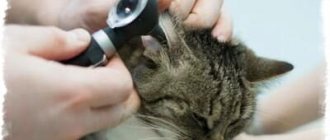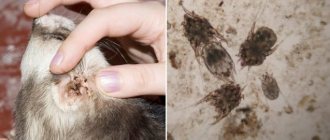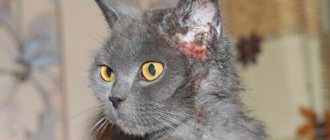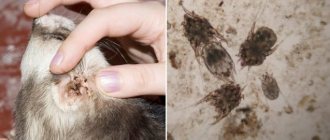- What causes acne?
- How does acne appear?
- Modern approaches to acne treatment
The appearance of black dots on a cat's chin does not cause concern to every pet owner. This approach to the condition of a pet’s skin is easily explained by the fact that blackheads or acne, it would seem, do not in any way affect the cat’s health and do not affect its general well-being. In fact, acne in cats, the treatment of which must be comprehensive, indicates not only health problems in the pet. In cases of bacterial infection, inflammation may develop with the formation of purulent foci, subcutaneous abscesses, phlegmon, and the like.
How can you treat acne in cats?
In the fight against this disease in four-legged furry patients, areas of inflammation are sometimes treated with a two-phase liquid makeup remover. By carefully soaking a cotton swab in this product, you need to remove dirt and excess sebum - this is an excellent disinfection. This method is used only if there is no inflammation or pustules. Also, in the absence of wounds and ulcers, the use of folk remedies is allowed - you can treat acne with a composition of two furatsilin tablets mixed with pumpkin juice or boiled chamomile. In this case, lotions made from medicinal herbs – yarrow or celandine – can be effective.
In cases where acne is caused by allergies, switching to a different food or replacing plastic utensils with other materials - earthenware or metal - can help.
Varieties
Unnoticed blackness in the beard area of a pet in time can lead to the formation of purulent wounds, in place of which a crust will subsequently form. Fungus, bacteria and other pathogenic microorganisms grow in the wound, causing a purulent-inflammatory process. The table shows the main types of sores in cats in the chin area:
| Type of ulcers | Peculiarities |
| Surface | Are the result of scratches or shallow bites |
| The skin becomes reddish and a white dot appears on it | |
| Mostly the abscess opens on its own and does not require any treatment. | |
| Deep | Manifest against the background of bites with damage to the deep layers of the epidermis |
| The damaged surface of the skin is very painful, but in appearance it is not very different from healthy | |
| When palpating, a compacted area is noticed | |
| Spicy or hot | The inflammatory response develops quickly |
| There is a red wound, in place of which a crust appears | |
| Cold | Accompanied by a deep abscess, which has a chronic course |
| Such ulcers are permanent and may not go away for several years. | |
| Often recur | |
| Benign | Purulent discharge contains many living leukocytes |
| The cat's immune system rejects the affected areas, resulting in thick, white pus that does not have a strong odor appear on the chin. | |
| Malignant | White blood cells in the exudate die off or are very weak, while the cancer cells are strong |
| If purulent spots are not eliminated in a timely manner, phlegmon develops. |
Cat acne on the chin
Acne on the cat's chin is one of the most common skin diseases in cats of any gender and age. Symptoms range from almost invisible comedones to extremely inflamed ones. Depending on the course of the disease, cats behave differently. Some people don't react at all to the appearance of pimples, while others experience itchy pain and get nervous.
Where acne appears on the chin, hair loss and redness of the skin can be observed. At the first stage, you may notice a slight “dirtyness” - this effect is created by black dots between the hair follicles. Often everything is limited to this symptom, but sometimes it can turn into swollen red lumps that rupture and bleed.
Why worry: main reasons
According to veterinarians, the main source that causes sores on the beard containing pus to appear is impaired function of the sebaceous glands.
Abscesses, scabs and ulcers on the lower jaw in kittens and adult cats are not uncommon and appear under the influence of external or internal factors. The second type includes the following reasons:
- frequent stress, as a result of which the sebaceous glands work with greater intensity;
- improper development of subcutaneous structures;
- weak defense mechanisms of the immune system.
Poor hygienic conditions provoke the development of many diseases.
Often, after eating a pet, grains or dirt remain on the pet’s fur, as a result of which a red, inflamed spot or purulent wound later forms. If the owners do not carefully monitor the pet’s hygiene and do not regularly clean its feeding dishes, then a lot of bacteria accumulate on its surface, they spread to the chin and the skin festers. A violation may also occur if the pet is rarely bathed. Cats of any breed are at risk, and experts note that sterilized individuals are less likely to suffer from ulcers and other wounds.
Effective treatment: ointments for acne in cats
Obviously, for recipes to combat acne in our pets, we need to turn to professionals. Local remedies are usually prescribed, which can be quite effective if used regularly - once every one to three days, or as needed. This is primarily mupirocin in the medicinal form of an ointment or cream. A gel with 2.5% benzoyl peroxide is also used - keep in mind that this product may cause irritation in some cats. Another drug for cat acne is a gel with a 075% metronidazole content, as well as a lotion or cream with a 0.01% -0.025% tretinoin content. Local preparations containing tetracycline, clindamycin, or erythromycin have also proven effective.
How to recognize the symptoms?
The cat is constantly itching because the affected area is itchy.
Uncleaned crumbs from the fur or dirty skin of the cat in the chin area lead to the formation of a wound that constantly gets wet and develops into an abscess. Owners may not observe disorders in their pet for a long time, which is why they do not begin to treat it in a timely manner. When black spots form on a cat’s chin, the following pathological signs are recorded:
- redness and swelling of the damaged epidermis;
- dandruff on fur;
- gradual increase in the number and size of pustules;
- swelling of the lower jaw;
- severe itching, causing the pet to constantly itch;
- bloody crusts.
At advanced stages of dermatological pathology, owners often notice that hair has fallen out in the area with damaged skin.
Risk groups and similar diseases
Signs of the disease are most often found in women, but children and adolescents periodically experience them due to weakened immunity. In place of the blisters, ulcers often form. When spread over the entire face, it becomes a threat to vision, which is especially important in the situation with children. Therefore, when checking with a specialized doctor about how to treat perioral dermatitis in children, it is worth paying a visit to an ophthalmologist.
In the case of teenagers, the disease may not be detected immediately, because, experiencing hormonal changes, boys and girls often encounter skin problems. Blackheads and acne affect most people, so it can be difficult to notice papules at an early stage. Patients prone to allergies also rarely accurately diagnose the disease. Perioral dermatitis in children is often attributed to hormonal imbalance.
Causes of perioral dermatitis
Various factors become prerequisites for the occurrence of the disease. It is generally accepted that the disease can occur in waves, during which the irritation on the skin passes and reappears. Doctors often identify hormonal changes as the cause of perioral dermatitis. Symptoms appear as a result of:
- the use of drugs based on corticosteroids, which provoke the occurrence of rosacea, acne, blackheads and other cosmetic problems
- pregnancy, when the body is at the stage of serious changes and hormonal changes. Dermatitis often worsens before the onset of menstruation.
- using inappropriate decorative cosmetics
- the use of pastes with fluoride, which provoke irritation of the epidermis
- chapping after walking in the cold or sunbathing
- infectious diseases
- problems with immunity. They are usually caused by not getting enough vitamins.
Having discovered a corresponding problem, it is better to immediately go to see a doctor and find out how to treat perioral dermatitis on the face in adults.
Preventive measures
To prevent black spots from popping up on your cat's face, you need to follow some prevention rules. It is worth surrounding your pet with care and attention so that it does not experience stress and other negative emotions that can affect the condition of its skin. It is important to feed your pet good, high-quality food that contains sufficient amounts of vitamins and beneficial microelements so that the cat’s immunity does not weaken.
In preventing ulcers in the chin area, it is important to keep your pet clean. It is necessary to clean the bowl regularly. It is better to give food from a metal bowl, since plastic absorbs pathogenic microorganisms that will be transmitted to the cat during the next meal. The chin is a difficult place to clean, so your pet cannot always clean it on its own after eating or walking outside. Owners are required to monitor this area and clean it if necessary. When bathing the animal, special shampoos are used.
Video
Authors):
Gerke A.N., Ph.D., dermatologist at the SovVet veterinary clinic, member of the European Society of Veterinary Dermatologists (ESVD), St. Petersburg
Journal:
No. 2-2021
Key words:
Feline acne
Keywords
: acne, cat
Summary
Feline acne is a common skin disease in the cat, that is believed to be an idiopathic disorder of follicular keratinization, and secondary infection is an important component of feline acne and the identification of these bacterial and fungal organisms may improve treatment outcome. Feline acne lesions were defined as comedones, crusts, erythema, alopecia, papules, swelling, pustules, nodules/fistulas, and scarring of the chin. Pruritus was reported in 35% of the affected cats. For treatment, mainly local topical therapy is used, including hygiene procedures, drugs containing benzoyl peroxide, mupirocin. In some cases, systemic antibiotic therapy is indicated.
annotation
Feline acne is a common skin disease in cats associated with impaired keratinization and secondary infection (bacterial or fungal), the identification of which is necessary for effective therapy. Clinical signs of feline acne include comedones, crusts, erythema, alopecia, papules, edema, pustules, nodules with fistulas, and scarring in the chin area. Itching occurs in 35% of cats. For treatment, local therapy is predominantly used, including hygiene procedures, drugs containing benzoyl peroxide, mupirocin. In some cases, systemic antibiotic therapy is indicated.
Photo 1. Comedones in the chin area of a cat with acne
Not
Introduction
Feline acne is a common skin disease of cats associated with an idiopathic disorder of follicular keratinization. While some cats experience spontaneous regression and this may be the only episode of acne in their lives, in others the disease recurs and is regularly complicated by severe furunculosis. The pathogenesis of this problem is not fully known; it is believed that predisposing factors may be insufficient grooming, stress, a tendency to seborrheic disorders, excessive secretion of the sebaceous glands, immunosuppression, including those associated with chronic viral infections. However, none of these reasons is mandatory in every clinical case. Acne in cats, as a rule, is not associated with hormonal imbalances.
Photo 2. Comedones, alopecia, erythema, papules in a cat with acne due to food allergies. The lesions are accompanied by itching.
Clinical signs
Clinically, feline acne may present as comedones, crusts, erythema, alopecia, papules, edema, pustules, nodules, fistulas, or scars (Table 1). The first clinical manifestations may be crusts and comedones on the skin of the chin and on the border with the lower lip, less often on the upper lip and the commissure area. Since no other symptoms are observed at this stage, owners usually do not notice signs of illness in their pet. In some cats, acne does not progress, remaining at the comedonal stage for a long time, while in others papules and pustules appear. In severe cases, purulent folliculitis, furunculosis or cellulitis develops. In severe cases, swelling of the chin and lips develops, and cats begin to intensively rub their chin on the surface and scratch with their paws. Regional lymphadenopathy rarely develops. Formation of follicular cysts and cicatricial alopecia is also possible in severe chronic cases. In most cases, lesions in the chin area may be the only cutaneous manifestation. Cats that, in addition to the characteristic lesions of the chin area, also have comedones, crusts, erythema and self-induced alopecia due to excessive licking in the area of the limbs, abdomen, groin, and muzzle, as a rule, have “atopic dermatitis” and require a systematic approach to diagnosis and therapy. Feline acne can develop at any age; there is no obvious breed or sex predisposition, but according to one review, male cats are more susceptible [3].
Table 1. Clinical signs of feline acne [3]
| Clinical sign | Occurrence (%) |
| comedones | 73% |
| alopecia | 68% |
| crusts | 55% |
| papules | 45% |
| erythema | 41% |
| edema | 18% |
| pustules | 9% |
| nodules/fistulas | 9% |
| scarring | 4,5% |
| itching | 35% |
Pathogenesis and histological changes
Histological examination reveals dilation and blockage of the sebaceous gland ducts with a lymphoplasmacytic inflammatory reaction of the duct walls. In a chronic course, fibrosis of the ducts may develop. In some cats with acne, pyogranulomatous inflammation of the sebaceous glands is also detected. Often mural or even purulent folliculitis occurs with the development of furunculosis; in these cases, purulent exudate in the lumen of the follicles is revealed in the histobiopsy [3].
Photo 3. Acne complicated by furunculosis of bacterial etiology
Diagnostics
In most cases, the diagnosis is based on the characteristic clinical manifestations of lesions in the chin and lips. At the stage of comedones, the first diagnostic step after collecting history data, clinical examination and luminescent diagnostics is microscopy of skin scrapings to exclude feline demodicosis and cytological examination to identify Malassezia yeast-like fungi, bacteria, assess the nature of inflammation (eosinophilic, septic or sterile neutrophilic, pyogranulomatous, etc. .P.). Dermatophytosis should also be excluded, although it is extremely unlikely that acne will be the only manifestation of the infection, it is nevertheless worth considering the possibility of M. canis infection in cats, especially from shelters and dysfunctional catteries [4].
In furunculosis, it is necessary to identify a primary or secondary infectious cause through cytology and possibly bacteriology. The most common bacterial agents identified in feline acne are Escherichia coli,
alpha-hemolytic
Streptococcus
, coagulase-positive
Staphylococcus s, Bacillus cereus, Micrococcus sp.
Pseudomonas aeruginosa and others [4]. It is important to note that these bacteria can also be detected from the chin skin of clinically healthy cats, so the main etiological factors are disruption of the skin barrier, immunosuppression and defects in keratinization. Bacterial furunculosis that does not respond to empirical antibiotic therapy may require bacteriological testing.
In cases of severe swelling of the chin, a likely diagnosis may be feline eosinophilic granuloma complex, in which case cytological examination may reveal many eosinophils. Such cats are diagnosed with allergies, including regular treatments for parasites, exclusion diets, and drug therapy is selected.
If viral infections are suspected, PCR tests are performed on skin biopsies to detect the herpes virus (feline herpes virus-1) and feline calicivirus. Based on immunohistochemistry studies [3], these common feline viral infections do not appear to be the primary cause of acne in cats. However, these infections must be taken into account in ulcerative lesions accompanied by eosinophilic inflammation, since immunosuppressive therapy in these cases may worsen the patient's condition.
Feline herpesvirus infection caused by FHV-1 has been described as a cause of ulcerative skin lesions in the muzzle and dorsum of the nose. On histological examination, the characteristic cutaneous manifestations of FHV-1 are vesicles, ulcers, crusts, and necrosis, often with eosinophilic infiltration [1].
There is a report on the use of immunohistochemistry to confirm calicivirus as the cause of acne in cats that is refractory to standard therapy [3]. Calicivirus infection of cats is usually characterized by damage to the upper respiratory tract, erosive-ulcerative glossitis, chronic lymphoplasmacytic or proliferative stomatitis, pneumonia, and damage to the paw pads, accompanied by lameness. Cutaneous manifestations of calicivirus include swelling of the skin (usually the distal parts of the extremities), alopecia, crusted lesions most often in the nose, lips, ears, paws and lesions around the eyes. One of the rare manifestations of calicivirus, along with skin manifestations, is also febrile hemorrhagic syndrome [2], leading to death in 50% of cases. This syndrome is accompanied by fever, anorexia, jaundice, vomiting, diarrhea and respiratory manifestations. Skin lesions first appear on the paw pads and consist of neutrophilic inflammation and necrosis. Histological examination of the skin with calicivirosis reveals necrosis of the basal and spinous layers, as well as the follicular epidermis and ulceration of the skin. In the most chronic cases, necrosis of all layers of the epidermis with balloon degeneration of the surface layers is detected; the boundaries of the epithelium and subepithelial structures appear blurred. The deepest lesions are observed at the border of the skin covered with hair and hairless areas. The study found that only a portion of cats that had clinical manifestations and characteristic histological and immunohistochemical changes in skin biopsies had the antigen detected by PCR [3].
If feline demodicosis caused by Demodex cati is confirmed,
it is necessary to find the causes of immunosuppression, which may be drugs, chronic diseases, including chronic viral infections caused by the immunodeficiency virus (FIV) and feline leukemia virus (FeLV).
Treatment
The need and intensity of therapy depends on the degree of clinical manifestations. If the cat owner does not pay attention to comedones, and this is the only clinical sign, then there is no need to prescribe treatment for such an animal. If the lesions progress, are complicated by secondary infection, or are accompanied by itching, therapy is necessary.
In most cases of feline acne, topical therapy is preferred. It is recommended to pre-cut the hair in the affected area for ease of application and increase effectiveness. If you have fistulas and boils, you can make lotions with a warm solution of magnesium sulfate (2 tablespoons per liter of water) for 5 to 10 minutes. In the presence of boils and fistulas caused by a bacterial infection, use appropriate antibiotics orally for 14 to 21 days. The choice of antibiotic depends on the type and sensitivity of microorganisms; in most cases, amoxicillin-clavulanate, fluoroquinolones or cephalosporins can be used for empirical therapy [4]. Alcohol-containing preparations, various cleansing wipes, and the antiseptic Listerine can be used as comedolytic agents, however, most researchers prefer the use of antiseborrheic shampoos containing ethyl lactate or benzoyl peroxide on a daily to twice weekly basis. Benzoyl peroxide has significant benefits in helping to unclog hair follicles, but may cause irritation in some cats, in which case it should be discontinued. The use of gels and lotions containing metronidazole, clindamycin, tetracycline, or erythromycin has also been described. Topical treatments with mupirocin may reduce the need for systemic therapy. Applying mupirocin cream twice a day is most effective [5].
As clinical recovery progresses (in the absence of papules and comedones), treatment can be gradually discontinued over several weeks. For cats with a history of recurrent acne, regular cleansing procedures are recommended.
Some cats benefit from fatty acid supplementation.
Other than antibiotic therapy and fatty acid supplementation, systemic therapy is rarely necessary. Cats with severe inflammation may be given an additional course of prednisolone for 10–14 days at a dose of 1–2 mg/kg per day orally, which can improve the condition and reduce scarring. However, any bacterial infections must be controlled before corticosteroids are prescribed.
In the absence of positive dynamics during local therapy, the administration of isotretinoin orally at a dose of 2 mg/kg/day is described. Positive dynamics of this therapy are observed only after 30 days in 30% of cats with acne. As the drug improves, the drug intake is reduced to once every 2–3 days [5].
Literature
1. Hargis AM, Ginn PE Feline herpesvirus-1-associated facial and nasal dermatitis and stomatitis in domestic cats. /Veterinary Clinics of North America Small Animal Practice, 1999; 6: 1281 – 1290.
2. Hurley K., Sykes J. Update on feline calicivirus: new trends. /The Veterinary Clinics of North America: Small Animal Practice, 2003; 33: 759 – 772.
3. Jazic E., Coyner KS, Loeffler DG, Lewis TP An evaluation of the clinical, cytological, infectious and histopathological features of feline acne./Veterinary Dermatology, 2006; 17 (2): 134 -140.
4. Scott DW, Miller WH, Griffin CE Keratinization defects / Muller and Kirk's Small Animal Dermatology, 6th edn. Philadelphia: WB Saunders, 2001: 1042 – 1043.
5. White SD, Bordeau PB, Blumstein Ph., Ibisch C., Ère EG, Denerolle Ph., Carlotti DN, Scott KV Feline acne and results of treatment with mupirocin in an open clinical trial: 25 cases (1994–96) / Veterinary Dermatology, 1997;
8 (3): 157 – 164. Back to section
Necessary treatment
If you notice a black chin on a cat or an area of the skin is covered with ulcers, then you should immediately show your pet to a veterinarian and take therapeutic measures. The beard is treated with the medications presented in the table:
| Medication group | Name |
| Antiseptic drugs | "Chlorhexidine" |
| "Miramistin" | |
| Hydrogen peroxide | |
| Shampoos for cat hygiene | "Bifar" |
| "Hartz" | |
| "Doctor" | |
| "Lactoderm" | |
| Medicines against ulcers in the form of ointments and gels | "Flucinar" |
| "Synthomycin liniment" | |
| Sulfuric ointment |
The affected area is washed with a decoction.
If crusts or spots have formed in the fur, it is possible to get rid of them by using iodine. Medicines based on natural ingredients are also effective for purulent wounds in cats. Some medications can be prepared at home. A decoction made from calendula or chamomile inflorescence helps well with ulcers on cat skin. Dip a cotton swab into the resulting solution and fix it on the problem area of the chin. In a similar way, you can treat a cat using celandine.
Prohibited actions
If a cat's beard turns red or a scab appears, then you should not try to deal with the problem on your own. There are a number of actions that are prohibited when getting rid of ulcers on the chin:
- It is strictly forbidden to open a pimple on your own, as this will lead to infection and serious complications.
- Comb the pet's fur with a brush or stiff comb. Such actions provoke even greater irritation of the epidermis and cause discomfort to the pet.
- Use ointments and antiseptics in large quantities. Only damaged chin tissue needs to be treated; in no case should you wipe healthy tissue, which can lead to overdrying. Ointments are also applied only to the abscess itself in a small layer so that the cat does not lick it off.
Allergy to animals
Have you or your child ever experienced red spots or blisters on your skin if a cat licked you, or symptoms of conjunctivitis if you petted a cat and then rubbed the same hand over your eye? Most likely, you have sensitivity (from the Latin sensibilis sensitive) to cat allergens.
Sensitization to pets most often manifests itself as symptoms of respiratory, and less commonly, skin allergies. Signs of respiratory allergies manifest themselves in the form of symptoms from the nose (stuffiness, sneezing, mucous discharge), eyes (itching, redness, lacrimation) and lower respiratory tract (dry cough, wheezing in the chest, shortness of breath, suffocation); and skin – in the form of itching, redness of the skin.
Allergy symptoms
in pets vary in severity, ranging from mild discomfort associated with rhinitis and conjunctivitis, to life-threatening attacks of bronchial asthma.
Mammals kept as pets are an important source of allergies, and sensitization to animal dander of various species appears to be increasing worldwide. Pet allergens are mainly present in their fur, saliva and urine and are released into the external environment when they shed or shed dander.
Among pet allergens, cat allergens are the most potent. Cats are the cause of allergic diseases more often than dogs and other pets. The most important cat allergen, Fel d1, found in saliva and sebaceous glands, is present in cats of all breeds. Unneutered cats have more of it than females. Particles of desquamated cat epithelium up to 2.5 microns in size can remain in indoor air for a long time and penetrate into the lungs, causing exacerbation of allergic rhinitis in sensitive individuals, months after the animal is removed from the home. Animal allergens, when they get on clothing, can be carried into rooms and public places where there are no animals themselves, and provoke exacerbations of allergic rhinitis and asthma in people sensitive to them.
Allergy to dogs
Less common than cat sensitivity. The main allergen, Can f1, with which it is associated, is found in the saliva and fur of any dog, but its amount depends on the breed.
Sensitization to cat and dog allergens is a risk factor for the development of bronchial asthma and rhinitis. This was shown in a study in which sensitization to key allergenic components of pets was observed in young children before the development of respiratory symptoms.
Sensitivity to allergens from other animals that are often kept in the family - gerbil mice, guinea pigs, rabbits, ferrets - is rare. Allergies to farm animals - horses, cattle, pigs - are also observed.
Bird feathers in pillows, feather beds, and down clothes also have significant allergenic activity. Allergies can also be caused by pigeons, parrots, and canaries kept in apartments. In addition to bronchial asthma, poultry can cause the development of allergic rhinitis and exogenous allergic alveolitis.
Representatives of lower crustaceans and various species of daphnia in dry food for aquarium fish also have pronounced allergenic activity. Cases of allergic rhinitis and bronchial asthma have been described among members of families keeping aquariums and using dry food from daphnia.
Allergy prevention measures
The best way to avoid the effects of animal allergens is to remove a cat, dog, or other animal from the home. After an animal is removed from the apartment, several months pass before the concentration of allergens drops below the threshold. If the family does not want or cannot part with the pet, then it should be placed outside the living quarters, or, if this is not possible, do not allow the animal into the bedroom, use a highly efficient air filter, change the covers on mattresses and pillows, although these measures also allow sufficiently reduce the amount of allergens.
An allergist-immunologist can help you understand all the issues related to the causes of complaints of sneezing, itching and redness of the eyes, cough, difficulty breathing or itchy skin, select drug therapy if necessary and prescribe a set of treatment and preventive measures. The specialist will give all the necessary recommendations to relieve you and your child from the unpleasant manifestations of allergies. You can make an appointment with an allergist-immunologist by calling the clinic’s contact center.
Information prepared for you by:
Fesenko Irina Davidovna - allergist-immunologist, Ph.D. Conducts a reception in the children's building on Usachev.









